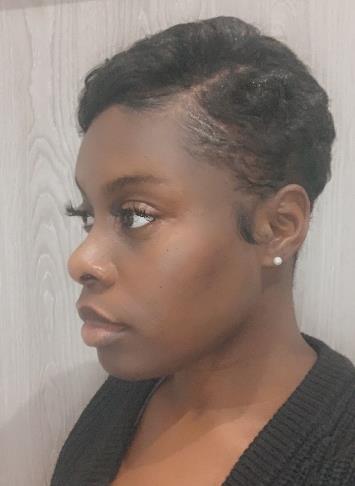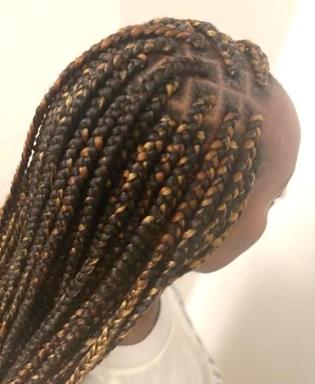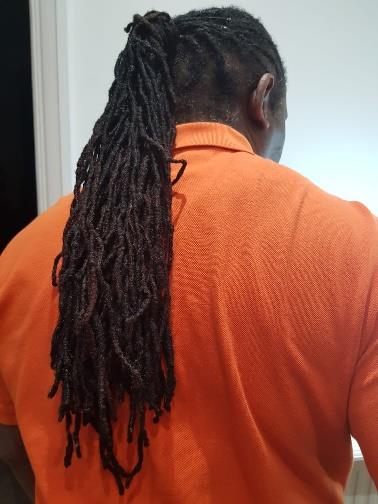
What are the aims of this leaflet?
This leaflet has been written to help you understand more about caring for Afro-textured hair. It tells you what Afro-textured hair is and how to minimise the risk of hair loss by certain haircare practices.
What is Afro-textured hair?
Afro-textured hair is generally thought of as the hair that is naturally seen in people of African descent. It is tightly curled and spring-like hair which elongates when stretched. Therefore, afro-textured hair can hold many shapes and styles, making it versatile and adaptable.
What makes Afro-textured hair different?
Naturally, Afro-textured hair has a number of different characteristics when compared with other hair types.
- The tight curl pattern of Afro-textured hair makes it more prone to dryness as the scalp’s natural moisturiser (sebum) cannot travel easily along the length of the hair like it can in straighter hair types. Because of this dryness, Afro-textured hair is more susceptible to breakage, split ends, and other types of damage.
- Research has shown that Afro-textured hair more frequently forms knots and tangles when compared to Caucasian and Asian hair. This can make Afro-textured haircare intricate. For example, simply passing a comb through Afro-textured hair can cause breakage as the hairs are unable to separate around the teeth of the comb without some of the strands breaking.
Importantly, some of the hair styling practices commonly used by people with Afro-textured hair can increase the risk of hair breakage and traction alopecia.
Recommendations for caring for natural hair

Natural hair is the term used to describe Afro-textured hair that has not had its texture altered with a chemical relaxer.
- Maintain a basic routine which includes washing the hair every 1-3 weeks, applying a rinse-out conditioner with or without heat, detangling carefully, drying gently and applying a leave-in conditioner.
- How often you wash your hair will depend on your hair type and the products used. A general rule is to wash the hair when there is excess product build-up or undesired oiliness. Not washing hair, when necessary, can lead to product build-up. This may irritate the scalp and cause, or worsen, seborrheic dermatitis (dandruff). Equally, washing the hair too frequently can cause dryness of the scalp and hair.
- Moisturise the hair regularly between wash days, using your choice of lotions, creams, and/or oils.
- Comb the hair using a soft brush with widely spaced bristles and coated tips, or a comb with widely spaced teeth.
- At bedtime, loosely plait or twist the hair and cover with a satin or silk cap or scarf. Sleeping on a satin or silk pillowcase will achieve the same goal of minimising friction.
Recommendations for caring for relaxed hair

Relaxed hair is hair that has been permanently straightened using a special cream, known as a relaxer. As the hair grows, a relaxer will need to be applied to any new growth to maintain straightness.
- Hair relaxers should be applied by a trained and experienced professional, who takes the special precautions detailed below.
- For touch-ups, relaxer should only be applied to new growth, and never to hair that has already been relaxed. This can make the hair irreparably fragile, leading to hair breakage.
- There should be a minimum interval of 6 weeks between relaxers. Taking breaks from relaxers for some months can be helpful to give the hair a rest.
- A relaxer should never be left on long enough to burn the scalp. There is no benefit to leaving a relaxer on longer than specified on the instructions, and burns can lead to permanent hair loss.
- The hair stylist should apply a protectant such as Vaseline along the scalp partings, hairline and around the ears to prevent damage to the skin and scalp. When relaxers come into contact with skin, they can cause irritant or allergic contact dermatitis. This is a type of eczema caused by contact with a particular product. This appears as an irritable, dry, itchy rash.
- If the relaxer comes with a neutralising shampoo, the hair stylist should use this to wash out the relaxer.
- Dyeing the hair soon after using a relaxer will cause cumulative damage, as will using excessive heat on the hair. A 2-week interval between relaxing and dyeing or heat straightening is recommended.
- There have been reports of relaxer use being associated with a higher risk of central centrifugal cicatricial alopecia (CCCA), a type of scarring hair loss seen in black women.
Recommendations for caring for braided hair

Braids come in various forms (box braids, knotless braids, cornrows, etc). The hair is divided into sections and braided with or without additional extensions into three-strand plaits or two-strand twists. Cornrows or Canerows (British pronunciation) are braids where the strands are interlocked flat to the scalp in stationary rows. Braids can be a beneficial and protective hairstyle when done correctly, as the hair is stretched, and the risk of knotting is reduced whilst the hair is braided.
- Braids should be installed by a trained and qualified professional.
- Hair should not be braided too tightly. If the scalp is painful after installation, it is probably too tight and will increase the risk of traction alopecia. It should never be necessary to take painkillers to relieve a painful scalp after the hair is done.
- Consider leaving the delicate hairs at the periphery of the hairline (“edges”) out of the braids to avoid putting tension on the hairs there, as this is a common area for traction alopecia to occur.
- Braiding the hair soon after a relaxer can increase the risk of breakage.
- Braiding the hair with long extensions and/ or adding decorative ornaments like beads may add significant weight and increases the risk of traction alopecia.
- Braids should not be left in for longer than 6 weeks.
- Tying braids into tight ponytails or buns increases the risk of traction alopecia.
- Ideally, install braids in alternate directions to avoid repeated stress in one direction.
Recommendations for caring for hair styled using wigs and hair extensions

Wigs and hair extensions offer versatile hair styling. They can also be protective, as often the natural hair is braided into cornrows or twists and tucked away underneath the wig, protected from manipulation.
- It is important to ensure that the hair is being cleansed and moisturised whilst it is under the wig or weave and is not braided too tightly underneath.
- If the wig or hair extensions are being sewn in, they should not be sewn too tightly.
- Hair glues and gels used to secure wigs or extensions have been associated with irritant or contact dermatitis of the scalp, and can contribute to the worsening of traction alopecia. If an adhesive is used, this should not be applied on the hairline itself as it can add friction to the roots of the hairs here. Furthermore, hair glue and gels used to secure the wig or weave can rip out the edges when removed. Ifan adhesive is required, it should be applied just forward of the hairline.
- If some of your own hair is left out to cover the tracks of the extensions or wig, ensure that hair is taken care of and kept moisturised. It is common to use heat to straighten or curl the hair that is left out to match the texture of the weave, and this can cause long term damage to the hair if done excessively.
- It is important to ensure that the edges are protected from damage caused by the wig rubbing on the hairline and causing friction. If a wig cap is worn, one made of satin is less likely to cause frictional damage than cotton or nylon ones. Satin is less likely to absorb moisture from the hair, reducing the risk of dryness. Extensions should not be left in for longer than 8 weeks.
Recommendations for caring for hair in locs

“Locs”, or dreadlocks, are traditionally strands of hair that have been joined and matted into rope-like fibres.
In recent times, “locs” is often considered to be the more culturally sensitive term, due to negative connotations with the term “dreadlocks”. Others are not of this viewpoint, and may continue to prefer to use the term “dreadlocks” or “dreads”.
- Hair can grow very long in locs, and many mistake that as being a measure of healthy hair. This is not necessarily the case, as long locs can become heavy and place tension on the scalp, increasing the risk of traction alopecia and hair loss. The risk is particularly high with this hairstyle as the locs are usually worn for several years, causing continuous strain on the scalp.
- Avoid excessive tension at the root of the scalp caused by twisting the locs too tightly.
- It is important to develop a routine for cleansing the scalp and locs that works for you. It is important for locs to be dried thoroughly after washing, otherwise mould and mildew can build up.
Best practice tips for hair styling
- Taking breaks with protective styles can be beneficial. For example, take a 6-12 month break from relaxers, twist or braid the hair loosely without extensions or loosely cornrow the hair under a wig.
- Excessive manipulation of the hair increases the risk of damage. The highest risk of hair loss is amongst those who combine many hair practices. For example, relaxing the hair, straightening it with heat and then installing braids, all within a short period of time.
- Any hair that has already been lost will not grow back overnight and growing your hair will require patience and consistency. In cases of traction alopecia, hair regrowth may start after 3 months of stopping damaging hair practices, but can be permanent.
Where can I get more information about caring for Afro-textured hair?
Web links to relevant leaflets:
Central centrifugal cicatricial alopecia
Jargon Buster: https://www.skinhealthinfo.org.uk/support-resources/jargon-buster/
Please note that the BAD provides web links to additional resources to help people access a range of information about their treatment or skin condition. The views expressed in these external resources may not be shared by the BAD or its members. The BAD has no control of and does not endorse the content of external links.
This leaflet aims to provide accurate information about the subject and is a consensus of the views held by representatives of the British Association of Dermatologists: individual patient circumstances may differ, which might alter both the advice and course of therapy given to you by your doctor.

This leaflet has been assessed for readability by the British Association of Dermatologists’ Patient Information Lay Review Panel
BRITISH ASSOCIATION OF DERMATOLOGISTS PATIENT INFORMATION LEAFLET
PRODUCED | JULY 2023
NEXT REVIEW DATE | JULY 2026
Download a PDF of this page using the link below:
Download File